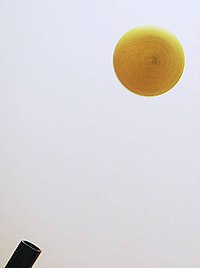康达效应
康达效应(英语:Coandă Effect;Coandă又译为康达、宽德、柯恩达),亦称附壁效应[1]。流体(水流或气流)离开本来的流动方向,改为随着凸出的物体表面流动之倾向,并使周围流体逸入此一喷流中。由于流体移动方向改变,使得周围产生压力较低的区域,此称为康达效应。[2][3]这种作用是以罗马尼亚发明家安利·康达(Henri Coandă)为名。安利·康达发明的一架飞机(康达-1910)曾经因这种效应坠毁,之后他便致力这方面的研究。[4][5]
发现
1800年,汤玛士·杨格在一场皇家学会的演讲中,提出了对康达效应的描述:
使蜡烛火焰往风管的气流靠拢的侧压,与气流通过障碍物时产生弯折的压力,很可能是一样的原理所造成。如果把一股气流在水面吹起的涟漪做标记,并且在气流的侧边放置一个凸面体,可以发现气流往凸面体的方向弯折了;如果凸面体是可以自由移动的话,还能发现它稍微往气流移动。
一百年后,亨利·康达在他的Coandă-1910型飞机实验中应用了这个效应。
示范实验
康达效应可以用小气流柱和乒乓球来示范。将吸尘器的管口往上倾斜一个角度,使气流从乒乓球上表面附近通过,当气流强度适中时,乒乓球的重力和其所受气压梯度力将可以平衡、让球浮在半空中。一个对康达效应常见的误解是水龙头的水通过汤匙背面时,汤匙会被拉进水流中的这个现象也属于康达效应。[6]与乒乓球的例子不同之处,在于水流和汤匙是在不同的相态中(液态和气态),逸入水流的空气其实相当稀少。汤匙之所以会往水流靠拢主要是表面张力的作用。[7]康达效应的例子还有:在一根点燃的蜡烛前放置罐子,对罐子吹气,气流可以将罐子后方的蜡烛吹熄。
在空气动力学中的应用
附壁作用是大部分飞机机翼的主要运作原理。附壁作用的突然消失是飞机失速的主要原因。
部分飞机特别使用引擎吹出的气流来增加附壁作用,用以提高升力。美国波音的YC-14 及前苏联的安-72都是把喷射发动机装在机翼上方的前面,配合襟翼,吹出的气流可以提高低速时机翼的升力。波音C-17环球霸王III亦有透过附壁作用增加升力,但所产生的升力较少。
直升机的“无尾旋翼”(英语:No Tail Rotor)技术,亦是透过吹出空气在机尾引起附壁作用,造成推力平衡主旋翼产生的反扭矩。
参考文献
- ^ 附壁效应 coanda effect (页面存档备份,存于互联网档案馆)-谢胜己《力学名词辞典》(2002年12月)
- ^ Tritton, D.J., Physical Fluid Dynamics, Van Nostrand Reinhold, 1977 (reprinted 1980), Section 22.7, The Coandă Effect.
- ^ 存档副本. [2018-04-09]. (原始内容存档于2020-10-22).
- ^ "The Coanda effect is a phenomenon that was first observed in 1910 by a mathematician and engineer named Henri Coandă. He discovered that when air was ejected from a rectangular nozzle, it would attach itself to an inclined flat plate connected to the nozzle exit. Emphasizing the need for a sharp angle between the nozzle and the flat plate, Coandă then applied the principle to a series of deflecting surfaces, each at a sharp angle to the previous one, and succeeded in turning flows through angles as large as 180. He stated that "when a jet of fluid is passed over a curved surface, it bends to follow the surface, entraining large amounts of air as it does so," and this phenomenon has become known as the Coandă Effect. On Some Recent Applications of the Coanda Effect Caroline Lubert International Journal of Acoustics and Vibration, Vol. 16, No. 3, 2011 http://www.iiav.org/ijav/content/volumes/16_2011_1739941303237209/vol_3/237_firstpage_856831320254369.pdf (页面存档备份,存于互联网档案馆)
- ^ Coandă effect. (2013). Columbia Electronic Encyclopedia, 6th Edition. Digital version available here: http://www.answers.com/topic/coanda-effectarchiveurl=https://web.archive.org/web/20120118131611/ archivedate=2012-01-18
- ^ "Mechanics of Fluids, 4th edition 1979, Van Nostrand Reinhold Company, New York, ISBN 0-442-30245-2, Fig, 3.12
- ^ "Understanding Aerodynamics Arguing from the Real Physics" Doug McLean, 2013, John Wiley & Sons Ltd. Chichester, ISBN 978-1-119-96751-4, Figure 7.3.6
